
Written, and photographs, by Armin du Preez – Director of Africa Scorpion Research
Scorpions may not be everybody’s cup of tea, but they deserve our respect. They have been around for millions of years; the oldest known fossil dates back to about 430 million years ago during the Silurian Period. During this Period, continental landmasses were low, and sea levels were rising. A warm, stable climate provided for one of the most significant developments to take place during the Silurian Period: the arrival of the first plants on land.
Lichens were followed by Bryophytes (moss, hornworts and liverworts) and Cooksonia, the first vascular plant with an upright stalk. This paved the way for terrestrial animals and the first known air-breathing animals: the Arthropods (animals with jointed legs). Millipedes, centipedes and the earliest arachnids first appear in the Silurian, and since arachnids (ticks, spiders, harvestmen, tailless whip-scorpions, short-tailed whip-scorpions, whip-scorpions, pseudo-scorpions, wind-scorpions and scorpions) are exclusively predatory, this represents the first terrestrial food web on Earth!
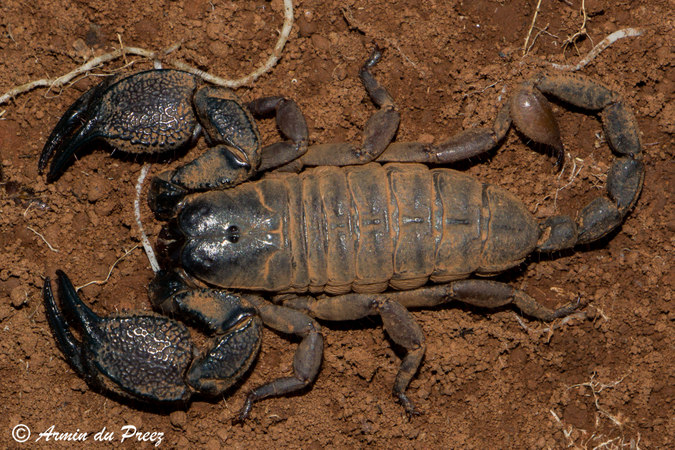
Today, scorpions are found on all major landmasses except Antarctica. Scorpions have always held our fascination, and interestingly, one of earliest occurrences of the scorpion in culture is its inclusion as Scorpio, in the zodiac – the 12 signs of the series of constellations by Babylonian astronomers during the Chaldean period.
Although venomous and fearsome in appearance, if treated with respect, scorpions are highly unlikely to pose any threat since they always attempt to escape when encountered. We have much to learn from them; already, there are biochemical secrets held in their venom from which mankind can benefit.
I find scorpions extremely fascinating; during self-defence, they stridulate by rubbing their chelicerae (mouthparts) together to produce a hissing sound. In some cases, they may drag the telson (sting) over the body segments (tergites) to produce a sudden scraping sound in an attempt to frighten off a predator.
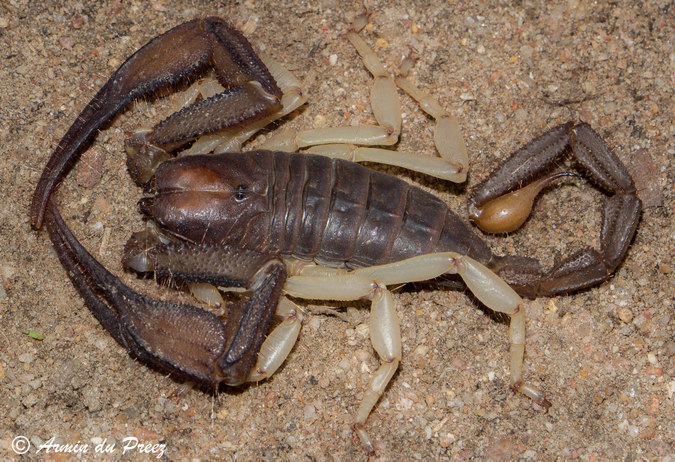
It is something to see when they are running away to safety, the way all eight legs work together, the tail in the air (and sometimes the tail is completely stretched out). The best part is to see how they manage to fit under tight rocks and skilfully disappear, leaving you in awe. You will find yourself wondering how such a weird looking animal can be so well adapted to its environment.
One of the most mesmerising things to observe is when they eat and how the chelicerae work together as a pair of appendages by prising the prey apart to consume it. Their beauty and uniqueness set them apart from any other animal I have encountered.
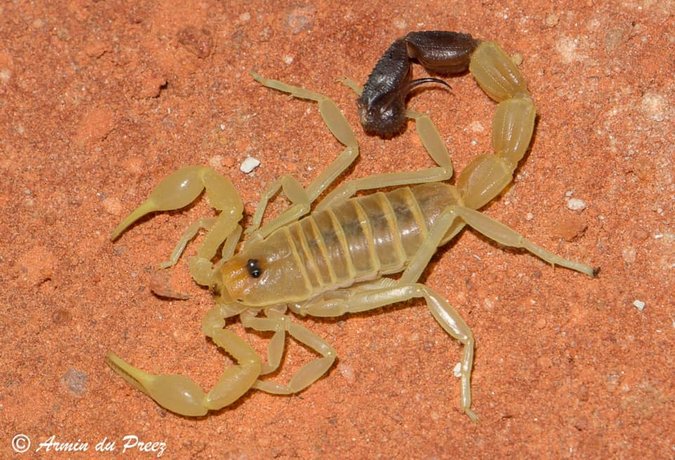
I recall my first encounter with a scorpion. The first thing which drew my attention was the movement of the pectines – the primary chemosensory organs of scorpions, which are paired, ventromedial appendages that brush the substrate as the scorpion walks. The soft feeling of its legs and claws as it moved over my hand, how it grabbed in self-defence with its pincers, and the power behind them, all made me realise that studying scorpions would become my passion and that I would champion their conservation by educating the public.
Next time you encounter a scorpion, take a closer look at this magnificent animal; you might just fall in love with it too!
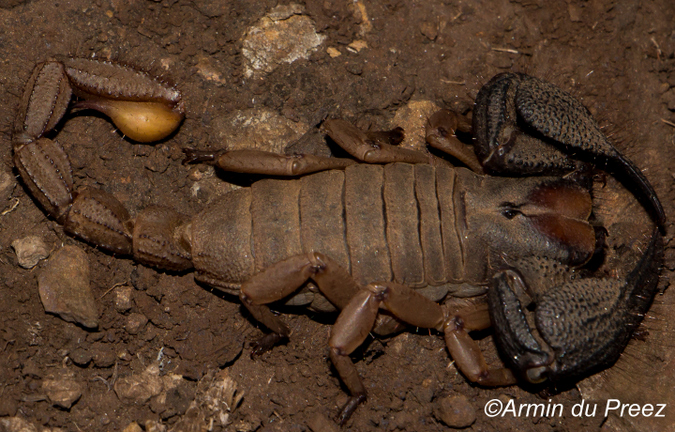
Of the 2,200 described species worldwide, around 160 species occur in southern Africa.
WHICH SCORPIONS SHOULD I LOOK OUT FOR?
We have 13 genera in southern Africa, of which the following six are often seen:
• Thick-tails (Parabuthus spp.)
• Lesser thick-tails (Uroplectes spp.)
• Pygmy thick-tails (Pseudolychas spp.)
• Burrowing scorpions (Opistophthalmus spp.)
• Creeping scorpions (Opisthacanthus spp.)
• Rock scorpions (Hadogenes spp.)
All the thick-tail venoms require urgent medical treatment. Stings from this genus are particularly severe in children, the elderly and the immune-compromised, but only two species are responsible for fatalities: the granulated thick-tailed scorpion (Parabuthus granulatus) and Transvaal thick-tailed scorpion (P. transvaalicus). The other species should also be considered as medically important, although fatalities from their stings are very rare.
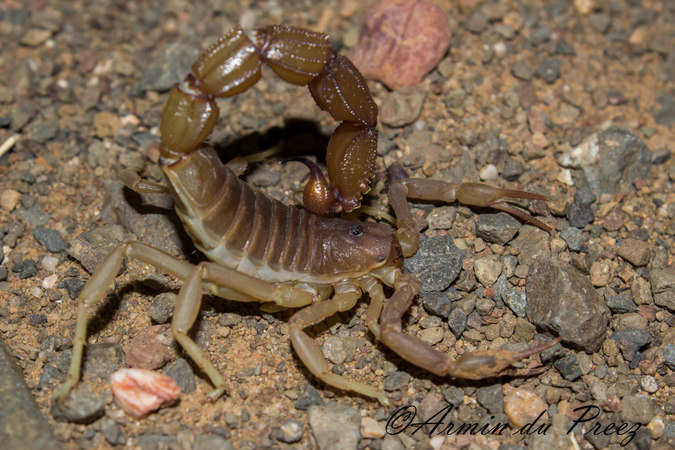
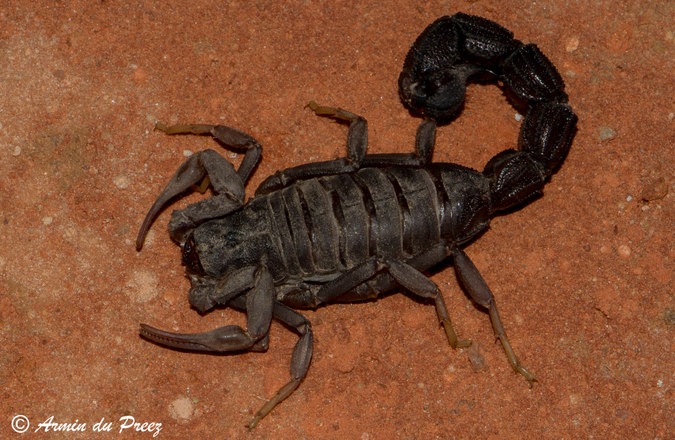
The stings from the lesser thick-tails, pygmy thick-tails and burrowing scorpions are excruciating, and the affected area will be very sensitive to touch, but these stings are not serious. The creeping- and rock scorpions rarely sting; their stings rarely result in more than just an itch lasting for a few seconds or minutes.
Thankfully, the majority of stings in Southern Africa are from lesser thick-tails and burrowing scorpions, which often wander into homes. As a general rule of thumb for our scorpions, weak pincers with a large tail indicate a potentially painful to serious sting, while strong pincers and thin tail indicate a “weak”, less serious sting.

SCORPION VENOM
All scorpions are venomous, but their venom differs between genera. Their venom consists of neurotoxic peptides, muco-polysaccharides, serotonin, histamine, hyaluronidase, phospholipase and enzyme inhibitors.
Scorpion venom has the potential to be used in analgesics, illumination of cancer cells, and brain-cancer treatment.
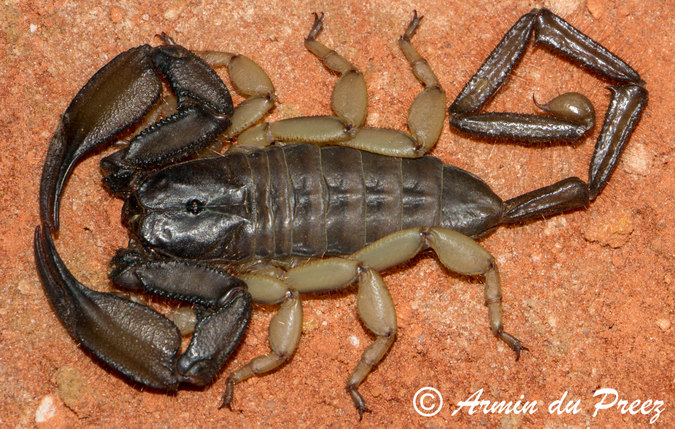
WHAT SHOULD I DO WHEN STUNG BY A SCORPION?
If stung by a thick-tail scorpion, it is essential to get to the hospital as soon as possible, while keeping the patient calm, and the affected area immobilised and still. Do not give alcohol or any medication such as morphine, or codeine which could suppress the symptoms. If pain relief is required, any medication containing paracetamol or aspirin will be adequate. Antivenom is available for granulated thick-tail and Transvaal thick-tail stings, but it should only be administered by a medical professional.
There are several myths and tales about treating scorpion stings, which are ineffective, if not harmful or outright dangerous: applying diesel or petrol to draw out the venom or killing the scorpion by rubbing it on the stung area to prevent symptoms.
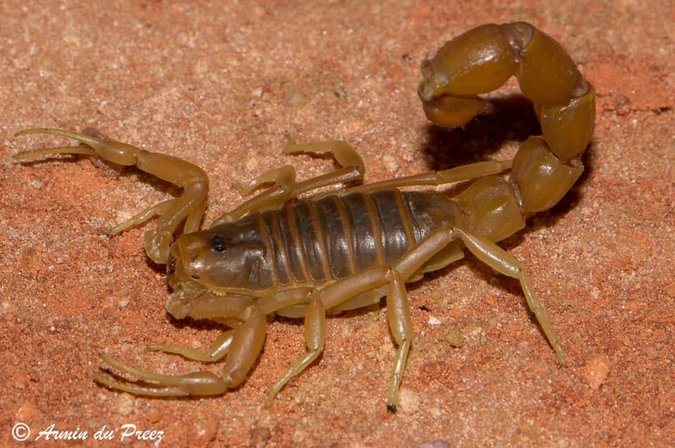
WHY DO SCORPIONS ENTER HOMES?
Some species have been known to wander into homes where they are often attracted by water or humidity, or else they are wandering males looking for females. Commonly seen in Gauteng is the plain pygmy thick-tail (Pseudolychas ochraceus), which is often found in bathrooms and sinks where it is seeking out moist environments. Scorpions will not infest a home, as they are solitary animals and will only be seen together during mating, or when a male guards a female after mating to deter other males from mating with her before he disperses.

WHY DO SCORPIONS ‘GLOW’ UNDER UV LIGHT?
It is the hyaline layer in the scorpion’s exoskeleton that reflects particular wavelengths of in the ultraviolet light spectrum. While we still don’t fully understand the reason behind this phenomenon, it is thought that perhaps this ability helps scorpions to better “see” their surroundings, or maybe attract their insect prey.

ARE SCORPIONS IMPORTANT IN THE NATURAL ENVIRONMENT?
As scorpions are very sensitive to environmental changes and will remain in the environment to which they have adapted, their presence in a particular environment is a good indicator the health of a specific ecosystem; an excellent reason to protect them and their environment.
Special care needs to be given to this group of animals and not only the larger and more well-known animals. If we protect scorpions, we will protect the world around us.
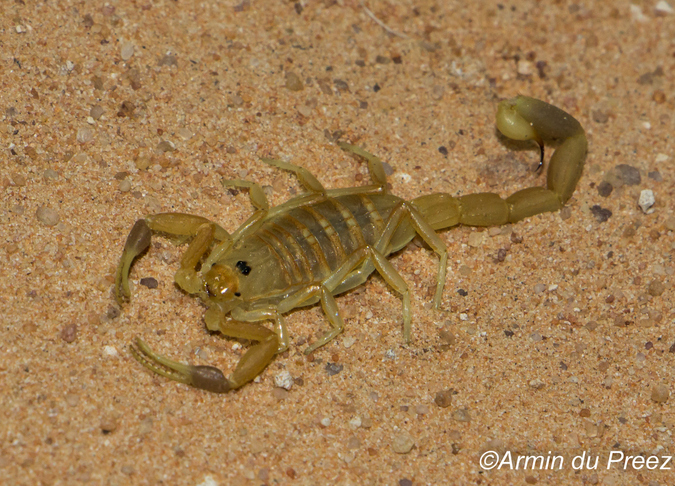
To comment on this story: Login (or sign up) to our app here - it's a troll-free safe place 🙂.![]()






